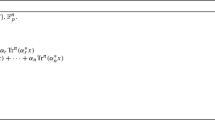Abstract
In 2018, Pott et al. have studied in (IEEE Trans Inf Theory 64(1):403-411, 2018) the maximum number of bent components of vectorial functions. They have presented many nice results and suggested several open problems in this context. This paper is in the continuation of their study in which we solve two open problems raised by Pott et al. and partially solve an open problem raised by the same authors. Firstly, we prove that for a vectorial function, the property of having the maximum number of bent components is invariant under the so-called CCZ equivalence. Secondly, we prove the non-existence of APN plateaued functions having the maximum number of bent components. In particular, quadratic APN functions cannot have the maximum number of bent components. Finally, we present some sufficient conditions that the vectorial function defined from \(\mathbb {F}_{2^{2k}}\) to \(\mathbb {F}_{2^{2k}}\) by its univariate representation:
has the maximum number of bent components, where \(\rho \le k\). Further, we show that the differential spectrum of the function \( x^{2^i}(x+x^{2^k}+x^{2^{t_1}}+x^{2^{t_1+k}}+x^{2^{t_2}}+x^{2^{t_2+k}})\) (where \(i,t_1,t_2\) satisfy some conditions) is different from the binomial function \(F^i(x)= x^{2^i}(x+x^{2^k})\) presented in the article of Pott et al.
Similar content being viewed by others
References
Budaghyan L., Carlet C.: On CCZ-equivalence and its use in secondary constructions of bent functions. In: Preproceedings of the International Workshop on Coding and Cryptography, WCC 2009, Ullensvang, Norway, pp. 19–36 (2009).
Carlet C.: Boolean functions for cryptography and error correcting codes. In: Crama Y., Hammer P. (eds.) The Monography Boolean Models and Methods in Mathematics, Computer Science, and Engineering, pp. 257–397. Cambridge University Press, Cambridge (2010).
Carlet C.: Vectorial Boolean functions for cryptography. In: Crama Y., Hammer P. (eds.) The Monography Boolean Models and Methods in Mathematics, Computer Science, and Engineering, pp. 398–469. Cambridge University Press, Cambridge (2010).
Carlet C.: Boolean and vectorial plateaued functions, and APN functions. IEEE Trans. Inf. Theory 61(11), 6272–6289 (2015).
Carlet C., Charpin P., Zinoviev V.: Codes, bent functions and permutations suitable for DES-like cryptosystems. Des. Codes Cryptogr. 15(2), 125–156 (1998).
Carlet C., Mesnager S.: On the construction of bent vectorial functions. Int. J. Inf. Coding Theory 1(2), 133–148 (2010).
Carlet C., Mesnager S.: Four decades of research on bent functions. Des. Codes Cryptogr. 78, 5–50 (2016).
Chabaud F., Vaudenay S.: Links between differential and linear cryptanalysis. In: Proceedings of EUROCRYPT’94. Lecture Notes in Computer Science, vol. 950, pp. 356–365 (1995).
Feng K., Yang J.: Vectorial Boolean functions with good cryptographic properties. Int. J. Found. Comput. Sci. 22(6), 1271–1282 (2011).
Matsui M.: Linear cryptanalysis method for DES cipher. In: Proceeding of EUROCRYPT’93. Lecture Notes in Computer Science, vol. 765, pp. 386–397 (1993).
Mesnager S.: Bent vectorial functions and linear codes from o-polynomials. Des. Codes Cryptogr. 77(1), 99–116 (2015).
Mesnager S.: Bent Functions: Fundamentals and Results, pp. 1–544. Springer, Basel (2016).
Nyberg K.: Perfect non-linear S-boxes. In: Proceedings of EUROCRYPT’ 91. Lecture Notes in Computer Science, vol. 547, pp. 378–386 (1992).
Pasalic E., Zhang W.G.: On multiple output bent functions. Inf. Process. Lett. 112(21), 811–815 (2012).
Pott A., Pasalic E., Muratović-Ribić A., Bajrić S.: On the maximum number of bent components of vectorial functions. IEEE Trans. Inf. Theory 64(1), 403–411 (2018).
Rothaus O.S.: On bent functions. J. Comb. Theory A. 20, 300–305 (1976).
Satoh T., Iwata T., Kurosawa K.: On cryptographically secure vectorial Boolean functions. In: Proceeding of Asiacrypt’99, pp. 20–28. Lecture Notes in Computer Science. Springer, Berlin (1999).
Tang C., Qi Y., Xu M.: New quadratic bent functions in polynomial forms with coefficients in extension fields. https://eprint.iacr.org/2013/405.pdf (2013).
Wu J., Wei Y., Wang X.: Optimized method for multiple output bent functions. Dianzi Xuebao (Acta Electron. Sin.) 33(3), 521–523 (2005).
Acknowledgements
The authors thank the Assoc. Edit. and the anonymous reviewers for their valuable comments which have highly improved the manuscript. F. Zhang is supported by Jiangsu Natural Science Foundation (BK20181352). C. Tang is supported by National Natural Science Foundation of China (Grant No. 11871058).
Author information
Authors and Affiliations
Corresponding author
Additional information
Communicated by C. Carlet.
Publisher's Note
Springer Nature remains neutral with regard to jurisdictional claims in published maps and institutional affiliations.
Rights and permissions
About this article
Cite this article
Mesnager, S., Zhang, F., Tang, C. et al. Further study on the maximum number of bent components of vectorial functions. Des. Codes Cryptogr. 87, 2597–2610 (2019). https://doi.org/10.1007/s10623-019-00639-4
Received:
Revised:
Accepted:
Published:
Issue Date:
DOI: https://doi.org/10.1007/s10623-019-00639-4



